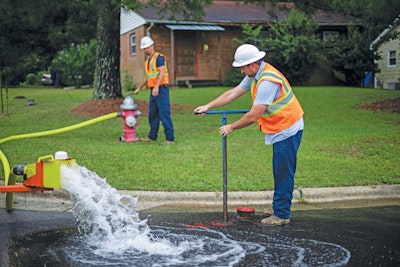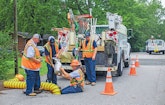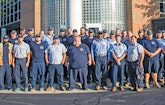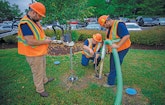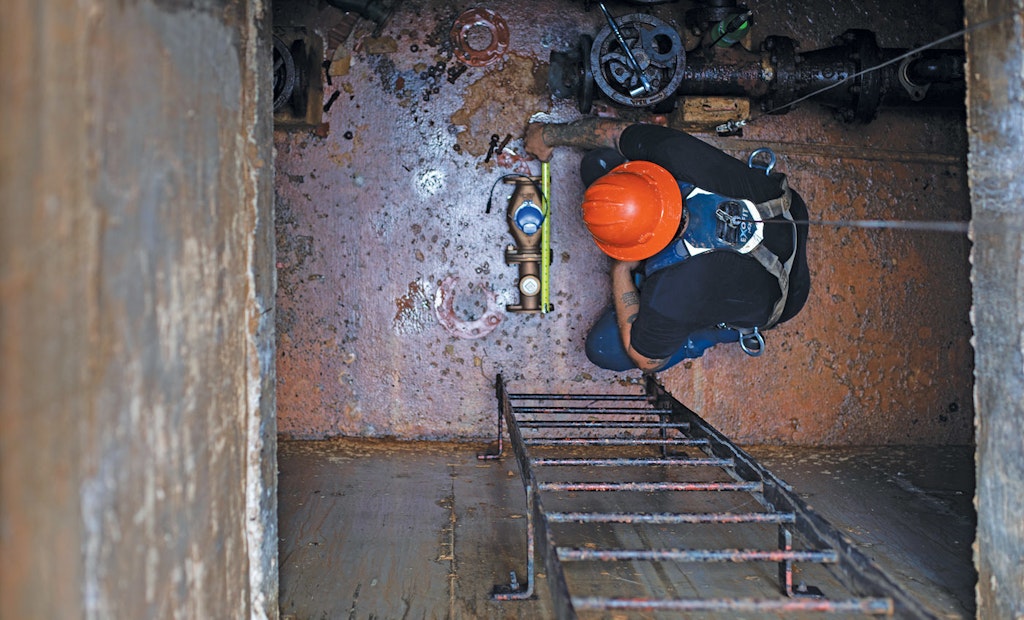
Nick Evans changes out a water meter on the University of North Carolina at Chapel Hill’s campus. OWASA has recently undertaken a $5 million water meter upgrade.
Four Cs drive the Orange Water and Sewer Authority, which serves the area around Chapel Hill, North Carolina: continuous improvement, customer service, conservation, and cross-training.
Those commitments helped OWASA earn the Presidents Award for Distribution System Operation from the American Water Works Association in 2017. The award recognizes achievement in the Partnership for Safe Water, a system optimization program supported by the AWWA and the U.S. Environmental Protection Agency. To date, OWASA is only the third utility in the nation to receive the award.
The missing C? Complacency. There’s none of it in OWASA.
“We’re always looking to improve,” says Randy Horton, manager of the Distribution and Collection Systems Department for OWASA. “We set those goals out there, and we want to provide the best service for our customers. We’re always striving to be the best we can be.”
Fifty years young
The OWASA was created in 1977, when the University of North Carolina at Chapel Hill sold off a group of university-owned utilities providing electric power, telephone service and water distribution.
The town of Chapel Hill owned its own sanitary sewer system, and the adjacent town of Carrboro had both a water distribution system and a wastewater collections system, buying its water from the University of North Carolina and contracting with Chapel Hill to treat its sewage. The University of North Carolina water system and the Chapel Hill and Carrboro water and wastewater assets were all sold to the new independent authority. OWASA now provides water and wastewater services to both towns along with the university and the southern part of Orange County.
The university is the primary industry in OWASA’s service area and the authority’s largest customer, says Mary Darr, OWASA engineering manager. The authority serves 22,000 customer accounts, representing a population of 83,000 people.
Continuous improvement
It’s not unusual for water and sewer systems to embark on major operational improvement programs after a crisis or some kind of wake-up call. Not so with OWASA. The authority joined the AWWA/EPA Partnership for Safe Water as a proactive maneuver.
“We didn’t start participating because there was an issue,” Darr says. “We started participating because we knew that we had opportunities to improve water quality and reliability, to develop a workforce that strives for excellence, and to maximize our customers’ investment in the infrastructure. It was our utility’s commitment to continuous improvement.”
That continuous improvement culture has led the authority to implement a series of measures over the last decade, starting even before it formally joined the Partnership for Safe Water.
In 2006, OWASA began a unidirectional flushing program. It started with the creation of system maps identifying which valves should be closed to properly flush the line. “You can go there and open a hydrant and flush, but if it’s drawing from three different directions, you’re not really cleaning that pipe the way we need to clean it,” Horton explains.
The flushing starts at the water plant and proceeds to the end of the system, cleaning the lines in the process. The cycle takes two years and then starts again.
“We have less discoloration of the water in our customers’ homes,” Horton says. “We’re able to verify that valves are working properly and are fully opened so that there are no restrictions in the mains. The labs are also testing water around our system, and they’re seeing the turbidity levels are much lower after we’ve completed flushing in those areas.”
Positive results early helped encourage the authority to continue the program, which has been in place for 12 years now.
Repair and replacement
OWASA also has an ongoing pipe replacement program.
“As we find pipes that are deteriorating or having issues, we review those issues and bring that back to our engineering department,” Horton says. Working with whichever government entity owns the roads where the pipes run, the authority then schedules the needed work.
The distribution system totals 380 miles of pipeline. While the oldest portion is cast iron pipe that goes back to the 1920s, about 80 percent of the system has been installed since 1972.
In 2003 OWASA implemented a prioritization model to guide pipe replacement projects, prompted by the availability of GIS mapping and the ability to integrate that with the authority’s work order management system. The model is updated every five to 10 years.
“The prioritization model that we use looks at a variety of different factors for each pipe,” Darr explains. “What the material is, how old it is, does it have critical customers on it, where is it located, and the break history.”
Guided by that model, the authority has focused replacement work on the system’s 100 miles or so of asbestos cement pipeline and also on small-diameter galvanized pipeline.
Goals — external and internal
In joining the Partnership for Safe Water program, the authority committed to a goal of keeping the number of water main breaks down to 15 or fewer per 100 miles in one year. Internally, OWASA is working to reduce the number to less than half of that; in 2017 the authority got close, with nine breaks per 100 miles.
Up to now, the authority has primarily employed traditional repair and replacement techniques, but it has begun to try some trenchless technologies, Horton says. Its first such project involved lining a stretch of 12-inch asbestos cement waterline on the University of North Carolina campus to avoid problems that open-trench repairs would have presented.
But OWASA is exercising caution on trenchless approaches, he adds, learning from each such project before proceeding with another.
The authority inspects pipes by taking water samples when new taps are made into the mainline, but TV inspection — routine on the sewer side — is far more difficult in the water distribution system, primarily because the pipes are much smaller: 8 inches in diameter or less.
Valves, connections and conservation
The authority also has a systematic procedure for inspecting air relief valves annually. The aim is to reduce or eliminate mainline breaks caused by pressure buildup from air trapped in the system.
“We annually test our interconnections between our neighboring cities,” Horton adds. “We want to verify that if they have a problem or we have a problem, we can transfer water from one city to another in an emergency.”
The authority has begun installing automatic metering capable of taking daily readings for leak detection.
“We can see if customers are having leaks that they may not even know about,” he says. When a customer’s meter is running continuously, OWASA will notify the account and see why that happens. “We’re able to conserve water by doing that.”
The authority has adopted a series of water conservation measures in the wake of droughts in the last decade. One of those involves using reclaimed wastewater to fulfill the university’s needs for irrigation, as well as to supply chiller plants on the campus.
Pressure detection devices have been installed in the system, and when they detect abnormal results, crews will investigate to identify the source of the problem.
Another program tests the system’s 12,859 valves regularly, at a rate of 400 a quarter, or 1,600 a year. At that rate, it takes about eight years to cycle through the entire system. The test date is recorded in OWASA’s Cityworks asset management system. “Then it generates a work order for the next reinspection,” Horton says.
Teamwork
The authority’s workforce numbers 140, of whom about 30 work in distribution. The other departments include wastewater collections, vehicle maintenance and the authority’s warehouse.
On the water side, a construction crew handles pipe replacement work and also takes charge of the unidirectional flushing and air relief valve inspection programs.
A maintenance and service crew repairs mainline breaks, makes new service connections for new construction on the system, handles the valve maintenance and operation program, and marks waterline locations when contractors call the local diggers’ hotline.
In the meter-reading customer service crew, six people read the 21,000 meters in the system each year. They also respond to customer inquiries and complaints, such as questions about water bills.
A meter and hydrant crew tests the meters regularly. “That’s our ‘cash register,’ so we have to make sure they’re accurate,” Horton says. The same personnel also maintain and repair fire hydrants on the system.
Cross-training
“We’re a small department, but we’re able to cross-train and help employees,” Horton adds. Cross-training extends to the other side of the agency, with wastewater collections system crews positioned to assist water distribution workers and vice versa.
Entry-level employees start as utility mechanics. A formalized training program allows them to train on specific skills, such as hydrant rebuilding, sewer cleaning, and the valve maintenance program. When they have met the training requirements for all the required Mechanic 2 skills, they can be promoted.
The program has helped ensure that more employees have a range of skills that enable them to help out co-workers as needed, Horton says.
That sense of common purpose is key to the culture at OWASA, and that extends to things like the Presidents Award.
“The award might be for the distribution system, but it’s not just the distribution system that takes part,” Horton says. “Our engineering department, our labs, all of them are involved in making this work.”
In the end, that team spirit is aimed at improving the experience of the authority’s customers — the water users who live and work in its service area.
“When water leaves the water treatment plant, it still has a long journey to make it to our customers,” Darr says. “It takes everybody in the organization working together to ensure the highest quality water gets to our customers.”
Working in partnership
The Presidents Award for Distribution System Operations that the Orange Water and Sewer Authority received in 2017 from the American Water Works Association is part of an ongoing Partnership for Safe Water, sponsored jointly by AWWA and the U.S. Environmental Protection Agency.
To date, more than 250 utilities serving a combined 100 million people have joined the partnership program, committing themselves to operational excellence in water treatment or distribution.
Participating utilities undertake a self-assessment and peer-review process. By successfully completing it, they can earn recognition through the partnership program, as OWASA did.
Nick Rogers, assistant to Randy Horton, who is manager of the OWASA Distribution and Collection Systems Department, points out that such recognition demands a long-term commitment on the part of the utility.
“It’s not just the one year that we applied for it,” Rogers says. “We’ve been with the partnership since 2012, and you have to be with the partnership and meet your goals every year and stay in good standing for several years. And everybody in the organization is doing their part.”
